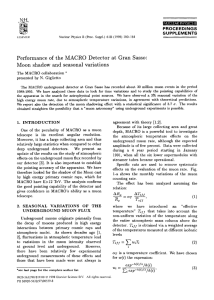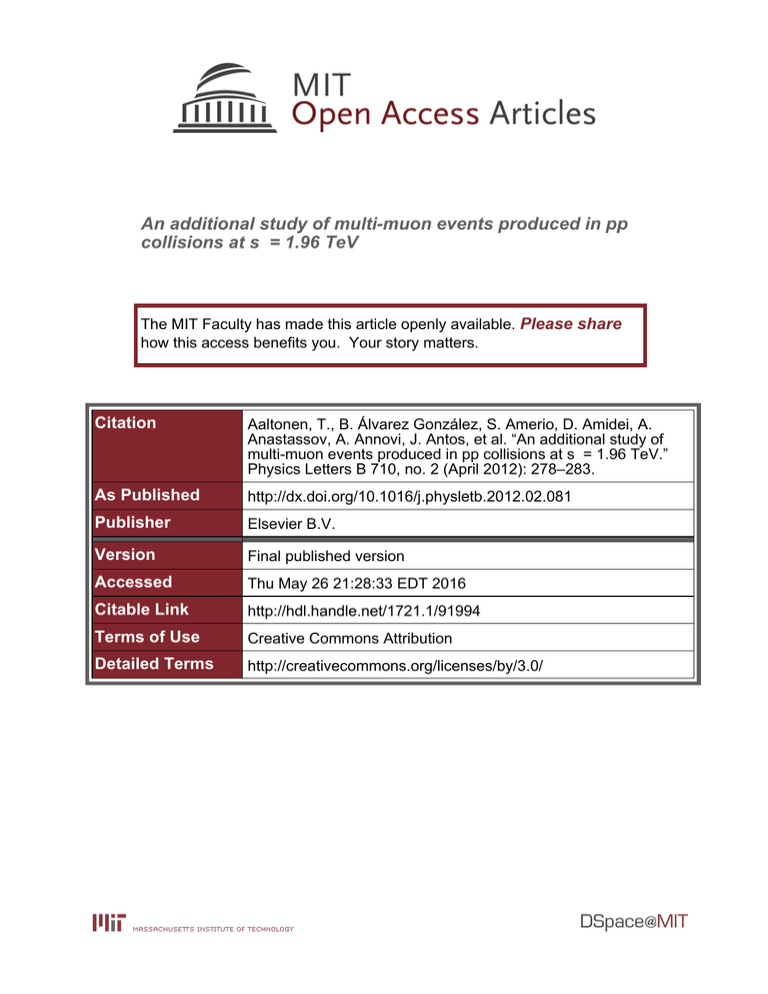
An additional study of multi-muon events produced in pp
collisions at s = 1.96 TeV
The MIT Faculty has made this article openly available. Please share
how this access benefits you. Your story matters.
Citation
Aaltonen, T., B. Álvarez González, S. Amerio, D. Amidei, A.
Anastassov, A. Annovi, J. Antos, et al. “An additional study of
multi-muon events produced in pp collisions at s = 1.96 TeV.”
Physics Letters B 710, no. 2 (April 2012): 278–283.
As Published
http://dx.doi.org/10.1016/j.physletb.2012.02.081
Publisher
Elsevier B.V.
Version
Final published version
Accessed
Thu May 26 21:28:33 EDT 2016
Citable Link
http://hdl.handle.net/1721.1/91994
Terms of Use
Creative Commons Attribution
Detailed Terms
http://creativecommons.org/licenses/by/3.0/
Physics Letters B 710 (2012) 278–283
Contents lists available at SciVerse ScienceDirect
Physics Letters B
www.elsevier.com/locate/physletb
An
√ additional study of multi-muon events produced in p p̄ collisions at
s = 1.96 TeV
CDF Collaboration
T. Aaltonen v , B. Álvarez González i,24 , S. Amerio as , D. Amidei aj , A. Anastassov an , A. Annovi r , J. Antos l,m ,
G. Apollinari p , A. Apresyan ba , T. Arisawa bl , A. Artikov n , W. Ashmanskas p , B. Auerbach bo , F. Azfar ar ,
W. Badgett p , A. Barbaro-Galtieri ae , V.E. Barnes ba , B.A. Barnett x , P. Barria ax , P. Bartos l,m , M. Bauce at ,
F. Bedeschi av , D. Beecher ag , S. Behari x , G. Bellettini aw , J. Bellinger bn , D. Benjamin o , A. Beretvas p ,
A. Bhatti bc , M. Binkley p,1 , D. Bisello at , I. Bizjak ag,28 , K.R. Bland d , B. Blumenfeld x , A. Bocci o , A. Bodek bb ,
D. Bortoletto ba , J. Boudreau az , A. Boveia k , B. Brau p,2 , L. Brigliadori f , A. Brisuda l,m , C. Bromberg ak ,
E. Brucken v , M. Bucciantonio aw , J. Budagov n , H.S. Budd bb , S. Budd w , K. Burkett p , G. Busetto at ,
P. Bussey t , C. Calancha ah , M. Campanelli ak , M. Campbell aj , B. Carls w , D. Carlsmith bn , R. Carosi av ,
S. Carrillo q,12 , S. Carron p , B. Casal i , M. Casarsa p , A. Castro f , P. Catastini u , D. Cauz bg , V. Cavaliere w ,
A. Cerri ae,7 , L. Cerrito ag,18 , Y.C. Chen a , G. Chiarelli av , G. Chlachidze p , F. Chlebana p , K. Cho y,z,aa,ab,ac,ad ,
D. Chokheli n , J.P. Chou u , W.H. Chung bn , Y.S. Chung bb , C.I. Ciobanu au , M.A. Ciocci ax , A. Clark s ,
C. Clarke bm , G. Compostella at , M.E. Convery p , M. Corbo au , M. Cordelli r , C.A. Cox g , D.J. Cox g ,
F. Crescioli aw , C. Cuenca Almenar bo , J. Cuevas i,24 , D. Dagenhart p , N. d’Ascenzo au,22 , M. Datta p ,
P. de Barbaro bb , S. De Cecco bd , M. Dell’Orso aw , L. Demortier bc , J. Deng o,4 , M. Deninno e , F. Devoto v ,
M. d’Errico at , A. Di Canto aw , B. Di Ruzza av , J.R. Dittmann d , M. D’Onofrio af , S. Donati aw , P. Dong p ,
M. Dorigo bg , T. Dorigo as , K. Ebina bl , A. Eppig aj , R. Erbacher g , D. Errede w , S. Errede w , N. Ershaidat au,27 ,
H.C. Fang ae , J.P. Fernandez ah , C. Ferrazza ay , R. Field q , G. Flanagan ba,20 , R. Forrest g , M.J. Frank d ,
M. Franklin u , J.C. Freeman p , Y. Funakoshi bl , I. Furic q , M. Gallinaro bc , J. Galyardt j , J.E. Garcia s ,
A.F. Garfinkel ba , P. Garosi ax , H. Gerberich w , E. Gerchtein p , S. Giagu be , V. Giakoumopoulou c ,
P. Giannetti av , K. Gibson az , C.M. Ginsburg p , N. Giokaris c , P. Giromini r , M. Giunta av , G. Giurgiu x ,
V. Glagolev n , D. Glenzinski p , M. Gold am , N. Goldschmidt q , A. Golossanov p , G. Gomez i ,
G. Gomez-Ceballos ai , M. Goncharov ai , O. González ah , I. Gorelov am , A.T. Goshaw o , K. Goulianos bc ,
C. Grosso-Pilcher k , R.C. Group bk,p , J. Guimaraes da Costa u , Z. Gunay-Unalan ak , C. Haber ae , S.R. Hahn p ,
E. Halkiadakis bf , A. Hamaguchi aq , J.Y. Han bb , F. Happacher r , K. Hara bi , D. Hare bf , M. Hare bj ,
K. Hatakeyama d , M. Herndon bn , S. Hewamanage d , D. Hidas bf , A. Hocker p , W. Hopkins p,8 , S. Hou a ,
R.E. Hughes ao , M. Hurwitz k , U. Husemann bo , M. Hussein ak , J. Huston ak , G. Introzzi av , M. Iori be ,
A. Ivanov g,16 , D. Jang j , B. Jayatilaka o , E.J. Jeon y,z,aa,ab,ac,ad , M.K. Jha e , S. Jindariani p , W. Johnson g ,
M. Jones ba , K.K. Joo y,z,aa,ab,ac,ad , S.Y. Jun j , T.R. Junk p , A. Kasmi d , Y. Kato aq,15 , W. Ketchum k ,
B. Kilminster p , D.H. Kim y,z,aa,ab,ac,ad , H.S. Kim y,z,aa,ab,ac,ad , H.W. Kim y,z,aa,ab,ac,ad , J.E. Kim y,z,aa,ab,ac,ad ,
M.J. Kim r , S.B. Kim y,z,aa,ab,ac,ad , S.H. Kim bi , Y.K. Kim k , N. Kimura bl , M. Kirby p , S. Klimenko q , K. Kondo bl ,
D.J. Kong y,z,aa,ab,ac,ad , J. Konigsberg q , D. Krop k , N. Krumnack d,13 , M. Kruse o , M. Kurata bi , S. Kwang k ,
A.T. Laasanen ba , S. Lami av , S. Lammel p , M. Lancaster ag , R.L. Lander g , K. Lannon ao,23 , A. Lath bf ,
G. Latino aw , H.S. Lee k , J.S. Lee y,z,aa,ab,ac,ad , S. Leo aw , S. Leone av , A. Limosani o,19 , C.-J. Lin ae , J. Linacre ar ,
M. Lindgren p , A. Lister s , D.O. Litvintsev p , C. Liu az , Q. Liu ba , T. Liu p , S. Lockwitz bo , A. Loginov bo ,
D. Lucchesi at , P. Lujan ae , P. Lukens p , G. Lungu bc , J. Lys ae , R. Lysak l,m , R. Madrak p , K. Maeshima p ,
K. Makhoul ai , S. Malik bc , G. Manca af,3 , A. Manousakis-Katsikakis c , F. Margaroli ba ,
R. Martínez-Ballarín ah , P. Mastrandrea bd , M.E. Mattson bm , P. Mazzanti e , K.S. McFarland bb ,
0370-2693/$ – see front matter © 2012 Elsevier B.V. All rights reserved.
doi:10.1016/j.physletb.2012.02.081
CDF Collaboration / Physics Letters B 710 (2012) 278–283
279
R. McNulty af,10 , A. Mehta af , P. Mehtala v , A. Menzione av , C. Mesropian bc , T. Miao p , D. Mietlicki aj ,
A. Mitra a , H. Miyake bi , S. Moed u , N. Moggi e , M.N. Mondragon p,12 , C.S. Moon y,z,aa,ab,ac,ad , R. Moore p ,
M.J. Morello p , P. Movilla Fernandez p , A. Mukherjee p , M. Mussini f , J. Nachtman p,14 , Y. Nagai bi ,
J. Naganoma bl , I. Nakano ap , A. Napier bj , C. Neu bk , M.S. Neubauer w , J. Nielsen ae,6 , O. Norniella w ,
E. Nurse ag , L. Oakes ar , S.H. Oh o , Y.D. Oh y,z,aa,ab,ac,ad , I. Oksuzian bk , T. Okusawa aq , R. Orava v ,
S. Pagan Griso at , C. Pagliarone bg , E. Palencia i,7 , V. Papadimitriou p , J. Patrick p , G. Pauletta bh , C. Paus ai ,
D.E. Pellett g , A. Penzo bg , T.J. Phillips o , G. Piacentino av , J. Pilot ao , K. Pitts w , C. Plager h , L. Pondrom bn ,
K. Potamianos ba , O. Poukhov n,1 , F. Prokoshin n,26 , A. Pronko p , F. Ptohos r,∗,9 , E. Pueschel j , G. Punzi aw ,
J. Pursley bn , A. Rahaman az , V. Ramakrishnan bn , N. Ranjan ba , I. Redondo ah , M. Rescigno bd , T. Riddick ag ,
F. Rimondi f , L. Ristori av,p , T. Rodrigo i , E. Rogers w , S. Rolli bj , R. Roser p , M. Rossi bg , F. Rubbo p ,
F. Ruffini ax , A. Ruiz i , J. Russ j , V. Rusu p , W.K. Sakumoto bb , Y. Sakurai bl , L. Santi bh , L. Sartori av , K. Sato bi ,
V. Saveliev au,22 , A. Savoy-Navarro au , P. Schlabach p , E.E. Schmidt p , M.P. Schmidt bo,1 , M. Schmitt an ,
T. Schwarz g , L. Scodellaro i , A. Scribano ax , F. Scuri av , A. Sedov ba , S. Seidel am , Y. Seiya aq , A. Semenov n ,
F. Sforza aw , A. Sfyrla w , S.Z. Shalhout g , T. Shears af , P.F. Shepard az , M. Shimojima bi,21 , S. Shiraishi k ,
M. Shochet k , I. Shreyber al , A. Simonenko n , A. Sissakian n,1 , K. Sliwa bj , J.R. Smith g , F.D. Snider p ,
A. Soha p , S. Somalwar bf , P. Squillacioti p , M. Stancari p , M. Stanitzki bo , R. St. Denis t , D. Stentz an ,
J. Strologas am , G.L. Strycker aj , Y. Sudo bi , A. Sukhanov q , I. Suslov n , K. Takemasa bi , Y. Takeuchi bi , J. Tang k ,
M. Tecchio aj , P.K. Teng a , J. Thom p,8 , J. Thome j , G.A. Thompson w , P. Ttito-Guzmán ah , S. Tkaczyk p ,
S. Tokar l,m , K. Tollefson ak , T. Tomura bi , S. Torre r , D. Torretta p , P. Totaro as , M. Trovato ay , F. Ukegawa bi ,
S. Uozumi y,z,aa,ab,ac,ad , A. Varganov aj , F. Vázquez q,12 , G. Velev p , C. Vellidis c , M. Vidal ah , I. Vila i ,
R. Vilar i , J. Vizán i , M. Vogel am , G. Volpi aw , R.L. Wagner p , T. Wakisaka aq , R. Wallny h , S.M. Wang a ,
D. Waters ag , B. Whitehouse bj , A.B. Wicklund b , E. Wicklund p , S. Wilbur k , J.S. Wilson ao , B.L. Winer ao ,
P. Wittich p,8 , S. Wolbers p , H. Wolfe ao , T. Wright aj , X. Wu s , Z. Wu d , K. Yamamoto aq , J. Yamaoka o ,
T. Yang p , U.K. Yang k,17 , Y.C. Yang y,z,aa,ab,ac,ad , W.-M. Yao ae , G.P. Yeh p , K. Yi p,14 , J. Yoh p , K. Yorita bl ,
T. Yoshida aq,11 , G.B. Yu o , I. Yu y,z,aa,ab,ac,ad , S.S. Yu p , J.C. Yun p , A. Zanetti bg , Y. Zeng o , S. Zucchelli f
a
Institute of Physics, Academia Sinica, Taipei, Taiwan 11529, ROC
Argonne National Laboratory, Argonne, IL 60439, USA
c
University of Athens, 157 71 Athens, Greece
d
Baylor University, Waco, TX 76798, USA
e
Istituto Nazionale di Fisica Nucleare, Bologna, Italy
f
University of Bologna, I-40127 Bologna, Italy
g
University of California, Davis, Davis, CA 95616, USA
h
University of California, Los Angeles, Los Angeles, CA 90024, USA
i
Instituto de Fisica de Cantabria, CSIC–University of Cantabria, 39005 Santander, Spain
j
Carnegie Mellon University, Pittsburgh, PA 15213, USA
k
Enrico Fermi Institute, University of Chicago, Chicago, IL 60637, USA
l
Comenius University, 842 48 Bratislava, Slovakia
m
Institute of Experimental Physics, 040 01 Kosice, Slovakia
n
Joint Institute for Nuclear Research, RU-141980 Dubna, Russia
o
Duke University, Durham, NC 27708, USA
p
Fermi National Accelerator Laboratory, Batavia, IL 60510, USA
q
University of Florida, Gainesville, FL 32611, USA
r
Laboratori Nazionali di Frascati, Istituto Nazionale di Fisica Nucleare, I-00044 Frascati, Italy
s
University of Geneva, CH-1211 Geneva 4, Switzerland
t
Glasgow University, Glasgow G12 8QQ, United Kingdom
u
Harvard University, Cambridge, MA 02138, USA
v
Division of High Energy Physics, Department of Physics, University of Helsinki and Helsinki Institute of Physics, FIN-00014, Helsinki, Finland
w
University of Illinois, Urbana, IL 61801, USA
x
The Johns Hopkins University, Baltimore, MD 21218, USA
y
Center for High Energy Physics, Kyungpook National University, Daegu 702-701, Republic of Korea
z
Seoul National University, Seoul 151-742, Republic of Korea
aa
Sungkyunkwan University, Suwon 440-746, Republic of Korea
ab
Korea Institute of Science and Technology Information, Daejeon 305-806, Republic of Korea
ac
Chonnam National University, Gwangju 500-757, Republic of Korea
ad
Chonbuk National University, Jeonju 561-756, Republic of Korea
ae
Ernest Orlando Lawrence Berkeley National Laboratory, Berkeley, CA 94720, USA
af
University of Liverpool, Liverpool L69 7ZE, United Kingdom
ag
University College London, London WC1E 6BT, United Kingdom
ah
Centro de Investigaciones Energeticas Medioambientales y Tecnologicas, E-28040 Madrid, Spain
ai
Massachusetts Institute of Technology, Cambridge, MA 02139, USA
aj
University of Michigan, Ann Arbor, MI 48109, USA
ak
Michigan State University, East Lansing, MI 48824, USA
al
Institution for Theoretical and Experimental Physics, ITEP, Moscow 117259, Russia
am
University of New Mexico, Albuquerque, NM 87131, USA
an
Northwestern University, Evanston, IL 60208, USA
b
280
CDF Collaboration / Physics Letters B 710 (2012) 278–283
ao
The Ohio State University, Columbus, OH 43210, USA
Okayama University, Okayama 700-8530, Japan
aq
Osaka City University, Osaka 588, Japan
ar
University of Oxford, Oxford OX1 3RH, United Kingdom
as
Istituto Nazionale di Fisica Nucleare, Sezione di Padova–Trento, Italy
at
University of Padova, I-35131 Padova, Italy
au
LPNHE, Universite Pierre et Marie Curie/IN2P3-CNRS, UMR7585, Paris, F-75252, France
av
Istituto Nazionale di Fisica Nucleare, Pisa, Italy
aw
University of Pisa, Italy
ax
University of Siena, Italy
ay
Scuola Normale Superiore, I-56127 Pisa, Italy
az
University of Pittsburgh, Pittsburgh, PA 15260, USA
ba
Purdue University, West Lafayette, IN 47907, USA
bb
University of Rochester, Rochester, NY 14627, USA
bc
The Rockefeller University, New York, NY 10065, USA
bd
Istituto Nazionale di Fisica Nucleare, Sezione di Roma 1, Italy
be
Sapienza Università di Roma, I-00185 Roma, Italy
bf
Rutgers University, Piscataway, NJ 08855, USA
bg
Istituto Nazionale di Fisica Nucleare Trieste/Udine, I-34100 Trieste, Italy
bh
University of Udine, I-33100 Udine, Italy
bi
University of Tsukuba, Tsukuba, Ibaraki 305, Japan
bj
Tufts University, Medford, MA 02155, USA
bk
University of Virginia, Charlottesville, VA 22906, USA
bl
Waseda University, Tokyo 169, Japan
bm
Wayne State University, Detroit, MI 48201, USA
bn
University of Wisconsin, Madison, WI 53706, USA
bo
Yale University, New Haven, CT 06520, USA
ap
a r t i c l e
i n f o
Article history:
Received 4 January 2012
Received in revised form 10 February 2012
Accepted 27 February 2012
Available online 2 March 2012
Editor: L. Rolandi
*
a b s t r a c t
We present one additional study of multi-muon events produced at the Fermilab Tevatron collider and
recorded by the CDF II detector. We use a data set acquired with a dedicated dimuon trigger and
corresponding to an integrated luminosity of 3.9 fb−1 . We investigate the distribution of the azimuthal
angle between the two trigger muons in events containing at least four additional muon candidates to
test the compatibility of these events with originating from known QCD processes. We find that this
distribution is markedly different from what is expected from such QCD processes and this observation
strongly disfavors the possibility that multi-muon events result from an underestimate of the rate of
misidentified muons in ordinary QCD events.
© 2012 Elsevier B.V. All rights reserved.
Corresponding author.
E-mail address: f.ptohos@ucy.ac.cy (F. Ptohos).
1
Deceased.
2
Visitor from University of MA Amherst, Amherst, MA 01003, USA.
3
Visitor from Istituto Nazionale di Fisica Nucleare, Sezione di Cagliari, 09042
Monserrato (Cagliari), Italy.
4
Visitor from University of CA Irvine, Irvine, CA 92697, USA.
5
Visitor from University of CA Santa Barbara, Santa Barbara, CA 93106, USA.
6
Visitor from University of CA Santa Cruz, Santa Cruz, CA 95064, USA.
7
Visitor from CERN, CH-1211 Geneva, Switzerland.
8
Visitor from Cornell University, Ithaca, NY 14853, USA.
9
Visitor from University of Cyprus, Nicosia CY-1678, Cyprus.
10
Visitor from University College Dublin, Dublin 4, Ireland.
11
Visitor from University of Fukui, Fukui City, Fukui Prefecture, 910-0017, Japan.
12
Visitor from Universidad Iberoamericana, Mexico D.F., Mexico.
13
Visitor from Iowa State University, Ames, IA 50011, USA.
14
Visitor from University of Iowa, Iowa City, IA 52242, USA.
15
Visitor from Kinki University, Higashi-Osaka City, 577-8502, Japan.
16
Visitor from Kansas State University, Manhattan, KS 66506, USA.
17
Visitor from University of Manchester, Manchester M13 9PL, United Kingdom.
18
Visitor from Queen Mary, University of London, London, E1 4NS, United Kingdom.
19
Visitor from University of Melbourne, Victoria 3010, Australia.
20
Visitor from Muons, Inc., Batavia, IL 60510, USA.
21
Visitor from Nagasaki Institute of Applied Science, Nagasaki, Japan.
22
Visitor from National Research Nuclear University, Moscow, Russia.
23
Visitor from University of Notre Dame, Notre Dame, IN 46556, USA.
24
Visitor from Universidad de Oviedo, E-33007 Oviedo, Spain.
25
Visitor from Texas Tech University, Lubbock, TX 79609, USA.
26
Visitor from Universidad Tecnica Federico Santa Maria, 110v Valparaiso, Chile.
27
Visitor from Yarmouk University, Irbid 211-63, Jordan.
28
On leave from J. Stefan Institute, Ljubljana, Slovenia.
This Letter reports on one additional test on the possible origin
of multi-muon events observed at the Tevatron. These events were
identified in a previous study [1] of a data set acquired with two
central (|η| < 0.7) primary (or trigger) muons, each with transverse momentum p T 3 GeV/c, and with invariant mass larger
than 5 GeV/c 2 and smaller than 80 GeV/c 2 . That study shows that
many long-standing inconsistencies between measured and predicted properties of the correlated bb̄ production and semileptonic
decay at hadron colliders [2–5] could be explained by the presence of a relevant source of muons which appear to be mostly
produced beyond the beam pipe of radius 1.5 cm (this contribution is whimsically referred to as ghost events because they were
unnoticed or ignored by previous measurements). Within the large
uncertainty of the prediction, mostly based on simulations, the
observed rate of ghost events is found to be consistent with being produced by muons arising from in-flight-decays of pions and
kaons, or punchthrough of hadronic prongs from K S0 or hyperon
decays. However, a search in ghost events for additional muons
with p T 2 GeV/c and |η| 1.1 and contained in a cos θ 0.8
cone around the direction of a primary muon selects a small but
significant fraction of events with a large content of muon candidates that appears difficult to account for in terms of known
sources with the present understanding of the CDF II detector, trigger, and event reconstruction.
A more recent study by the CDF Collaboration [6] has improved the estimate of the contribution of ordinary sources to
ghost events. This study addresses in particular the contribution
from pion and kaon in-flight-decays. In 1426 pb−1 of data, there
CDF Collaboration / Physics Letters B 710 (2012) 278–283
Fig. 1. Distribution of the azimuthal angle δφ between the two trigger muons for all
events.
are 54 437 ± 14 171 ghost events and 12 169 ± 1319 ghost events
with three or more muons which cannot yet be accounted for with
ordinary sources.
In this Letter, we investigate the distribution of the azimuthal
angle (δφ ) between the two primary muons in events in which
both primary muons are accompanied by at least one (or two)
additional muon candidates in a cos θ 0.8 cone around their direction, and compare it to those for all QCD sources known to produce dimuon events: bb̄, c c̄, and Υ production or events in which
one trigger muon is due to hadrons misidentified as muons (cosmic rays are removed from the data sample and the contribution
of secondary interactions in the detector volume is negligible [1]).
As discussed in Ref. [1], known QCD sources produce a handful
of events with four and none with six muon candidates. However,
if the unaccounted multi-muon events were generated by a gross
underestimate of the number of additional muons mimicked by
hadrons in ordinary QCD events, the δφ distribution of primary
muons in multi-muon events would be similar to that of ordinary
QCD events in which the large contribution of next-to-leading order (NLO) terms due to initial and final state radiation results in a
broader δφ distribution than that predicted by the Born (LO) approximation. In fact, the δφ distribution of pairs of b hadrons or
jets is traditionally used to determine the relative contribution of
NLO to LO terms [7]. This type of comparison was also suggested
by Ref. [8], in which the excess of multi-muon events is modeled
with the decay of two colorless particles produced through the
281
exchange of a heavy object. In such a hypothetical case, their deviation from the back-to-back configuration in the azimuthal angle
(δφ = π ) is only caused by initial state radiation of the incoming
quarks and is expected to be small.
The study presented here uses a dimuon data set corresponding to an integrated luminosity of 3.9 fb−1 and selected with the
same requirements used in Ref. [1]. High precision charged particle
tracking is provided by a large central drift chamber surrounding
a trio of silicon tracking devices composed of eight layers of silicon microstrip detectors ranging in radius from 1.5 to 28 cm in
the pseudorapidity region |η| < 1 [9]. The tracking detectors are
inside a 1.4 T solenoid which in turn is surrounded by electromagnetic and hadronic calorimeters. Outside the calorimeters, drift
chambers in the region |η| 1.1 provide muon identification. We
search events for additional muons using tracks with p T 2 GeV/c
and |η| 1.1. The rate of additional muons mimicked by hadronic
punchthrough is estimated with a probability per track derived by
using kaons and pions from D ∗± → π ± D 0 with D 0 → K + π − decays [1,6,10]. The difference between observed additional muons
and predicted misidentifications is referred to as real muons.
The δφ distribution for all 3.9 M events is shown in Fig. 1. Fig. 2
compares to the corresponding heavy flavor simulations the δφ
distribution of trigger muons due to bb̄ and c c̄ production. This
figure is reproduced from Ref. [10] that has measured σb→μ,b̄→μ
and σc →μ,c̄ →μ in a dimuon data set corresponding to a luminos-
ity of 742 pb−1 . In the bb̄ case, the distribution has an average of
2.5 with a rms deviation of 0.8 rad. The long and important tail
extending to δφ = 0 is due to NLO terms and the non-perturbative
fragmentation function of b quarks. In c c̄ events, because of the
smaller quark mass, NLO terms are approximately a factor of three
larger and the fragmentation function is much softer. Accordingly,
the δφ distribution has a smaller average (2.4 rad) and a larger rms
deviation (0.9 rad).
The azimuthal-angle distribution for primary muons produced
by Υ (1S ) decays is expected to be similar to those for heavy
flavors because the final state contains a bleaching gluon recoiling against the Υ meson. This distribution, shown in Fig. 3, is
constructed using muon pairs with invariant mass in the range
9.28–9.6 GeV/c 2 . As in Ref. [10], the combinatorial background
under the Υ (1S ) signal is removed with a sideband subtraction
technique. A similar δφ distribution is also expected for those
cases in which one muon is mimicked by a track in the jet recoiling against a muon due to a heavy-quark semileptonic decay.
Fig. 3 shows the δφ distribution of primary muons when one
of them is mimicked by pions produced by K S0 decays. As in
Fig. 2. The distributions (•) of the azimuthal angle δφ between trigger muons due to (left) bb̄ and (right) c c̄ production are compared to the corresponding heavy flavor
simulations (◦). The distributions, reproduced from Ref. [10], are normalized to unit area.
282
CDF Collaboration / Physics Letters B 710 (2012) 278–283
Fig. 3. Distribution of the azimuthal angle δφ between the two trigger muons produced by Υ decays (left) and for events (right) in which one primary muon is mimicked
by a pion produced by an identified K S0 decay. The combinatorial background underneath the Υ and K S0 signals has been removed with a sideband subtraction method. The
data correspond to an integrated luminosity of 3.9 fb−1 .
Fig. 4. Distribution of the azimuthal angle δφ between the two trigger muons accompanied by at least (a) one or (b) two additional real muons in a 36.8◦ cone around their
direction.
Ref. [6], we select K S0 → π + π − with a π → μ misidentification
by combining primary muons with tracks of opposite charge and
p T 0.5 GeV/c. We select pairs consistent to those arising from
a common three-dimensional vertex. We also take advantage of
the K S0 long lifetime to suppress the combinatorial background.
We further require that the distance between the K S0 vertex and
the event primary vertex, corrected by the K S0 Lorentz boost, corresponds to ct > 0.1 cm. We select K S0 candidates with invariant
mass in the range 0.47–0.52 GeV/c 2 (see Fig. 3 of Ref. [6]), and
remove the combinatorial background with a sideband subtraction
technique.
In summary, the δφ distributions of primary muons produced
by known QCD processes peak at δφ π , and exhibit a significant
tail extending to δφ = 0. Depending on the production mechanism,
the mean and rms deviation of these distributions are in the range
of 2.4–2.5 rad and 0.7–0.9 rad, respectively.
The δφ distributions in the subset of events in which each trigger muon is accompanied by at least one or at least two additional
real muons are shown in Fig. 4. These δφ distributions, with mean
of 2.9 rad and rms deviation of 0.2 rad and without any tail below
δφ = 2.5 rad, are different from those of primary muons due to all
known QCD sources.
In conclusion, as mentioned earlier, within our present understanding of the CDF-detector response no known sources produce
events in which each cos θ 0.8 angular cone around a primary
muon contains at least two additional real muons. Had the additional muons been produced by a subtle failure of our method to
evaluate the fake-muon contribution, the resulting δφ distribution
of primary muons would have been found consistent with those
typical of ordinary QCD processes.
Acknowledgements
We thank the Fermilab staff and the technical staffs of the participating institutions for their vital contributions. This work was
supported by the U.S. Department of Energy and National Science
Foundation; the Italian Istituto Nazionale di Fisica Nucleare; the
Ministry of Education, Culture, Sports, Science and Technology of
Japan; the National Science Council of the Republic of China; the
Swiss National Science Foundation; the A.P. Sloan Foundation; the
Korean Science and Engineering Foundation and the Korean Research Foundation; the Science and Technology Facilities Council
and the Royal Society, UK; the Institut National de Physique Nucleaire et Physique des Particules/CNRS; the Russian Foundation
for Basic Research; the Ministerio de Ciencia e Innovación, Spain;
the European Community’s Human Potential Programme; the Slovak R&D Agency; and the Academy of Finland.
CDF Collaboration / Physics Letters B 710 (2012) 278–283
References
[1] T. Aaltonen, et al., Eur. Phys. J C 68 (2010) 109, doi:10.1140/epjc/s10052-0101336-0, arXiv:0810.5357.
[2] F. Abe, et al., Phys. Rev. D 55 (1997) 2546.
[3] B. Abbott, et al., Phys. Lett. B 487 (2000) 264.
[4] D. Acosta, et al., Phys. Rev. D 69 (2004) 012002.
[5] G. Apollinari, et al., Phys. Rev. D 72 (2005) 072002.
[6] T. Aaltonen, et al., Eur. Phys. J. C 71 (2011) 1720.
[7] D. Acosta, et al., Phys. Rev. D 71 (2005) 092001;
283
ATLAS Collaboration, arXiv:1102.2696;
CMS Collaboration, arXiv:1102.3194.
[8] R. Barbieri, et al., J. Phys. G 36 (2009) 115008.
[9] D. Acosta, et al., Phys. Rev. D 71 (2005) 032001;
R. Blair, et al., Fermilab Report No. FERMILAB-Pub-96/390-E, 1996;
C.S. Hill, et al., Nucl. Instrum. Methods Phys. Res. Sect. A 530 (2004) 1;
S. Cabrera, et al., Nucl. Instrum. Methods Phys. Res. Sect. A 494 (2002) 416;
W. Ashmanskas, et al., Nucl. Instrum. Methods Phys. Res. Sect. A 518 (2004)
532.
[10] T. Aaltonen, et al., Phys. Rev. D 77 (2008) 072004.

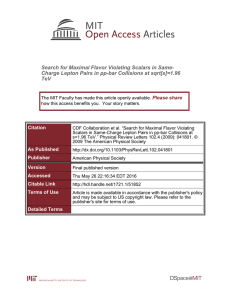
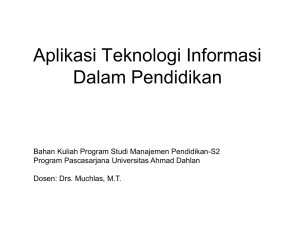
![Search for New Physics in High p [subscript T] Like-Sign](http://s2.studylib.net/store/data/012605321_1-dbcc17319cb8b74fcaa3ef5b8841cd3d-300x300.png)
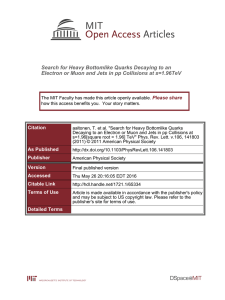

![Search for B[superscript ±][K[superscript ][superscript](http://s2.studylib.net/store/data/012104788_1-449da01c003119fd79672ecbbafdb55c-300x300.png)
